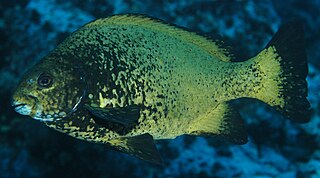
Gouramis, or gouramies, are a group of freshwater anabantiform fishes that comprise the family Osphronemidae. The fish are native to Asia—from Pakistan and India to Southeast Asia and northeasterly towards Korea. The name "gourami", of Indonesian origin, is also used for fish of the families Helostomatidae and Anabantidae.

The sea chubs, also known as rudderfish and pilot fish and in Hawaiian as enenue or nenue, are a family, Kyphosidae, of fishes in the order Perciformes native to the Atlantic, Indian and Pacific Oceans usually close to shore in marine waters.

Oplegnathus is currently the sole recognized genus in the knifejaw family (Oplegnathidae) of marine perciform fishes. The largest, the Cape knifejaw, can reach a maximum length around 90 cm (35 in). Knifejaws have teeth fused into a parrot-like beak in adulthood. They feed on barnacles and mollusks, and are fished commercially. They are native to the Indian and Pacific Oceans.

Characodon is a genus of splitfins endemic to north–central Mexico. Two of the species are highly threatened and restricted to pools, ponds and springs in the upper San Pedro Mezquital River basin in Durango. The third species, C. garmani, was restricted to springs near Parras in Coahuila, but it became extinct when they dried out.

Gymnocephalus is a genus of ray-finned fishes from the family Percidae, which includes the perches, pike-perches and darters. They are from the Western Palearctic area, although one species, Gymnocephalus cernua has been accidentally introduced to the Great Lakes region where it is regarded as an invasive species. They have the common name "ruffe" and resemble the true perches in the genus Perca, but are usually smaller and have a different pattern.

Oryzias is a genus of ricefishes native to fresh and brackish water in east and south Asia. Some species are widespread and the Japanese rice fish is commonly used in science as a model organism, while others have very small ranges and are threatened. They are small, up to 8 cm (3.1 in) long, and most are relatively plain in colour.

Zingel is a genus of fish in the family Percidae. They are long and slender, reaching 12 to 48 cm in length. They are found in rivers and streams in Europe. They feed mainly on aquatic invertebrates such as crustaceans and insect larvae, and also eat small fish. While they were all classed as endangered or vulnerable in the past, environmental improvements have allowed some to be reclassified to least concern.

Parachaetodon is a monotypic genus of butterflyfishes, the only species being the sixspine butterflyfish, which is also known as the ocellate butterflyfish or eyespot butterflyfish. is a species of butterflyfish native to tropical reefs of the eastern Indian Ocean and the western Pacific Ocean.

Siniperca is a genus of temperate perches native to freshwater habitats in East Asia and northern Vietnam, but the majority of the species are entirely or largely restricted to China.

Symphodus is a genus of wrasses native to the eastern Atlantic Ocean and the Mediterranean Sea.

Bangana is a genus of fish in the family Cyprinidae, the carps and minnows. It is distributed across much of southern and eastern Asia. Species live mainly in the flowing waters of tropical and subtropical rivers.
Sinilabeo is a genus of cyprinid freshwater fish found in China and Vietnam.

Halophryne is a genus of toadfishes found in the Pacific and Indian Oceans.

Synbranchus is a genus of swamp eels native to Central and South America.

Pseudocaranx is a genus of ray-finned fishes from the family Carangidae, the jacks, trevallies, scads, and pompanos. They occur in the western Atlantic Ocean and the Indo-Pacific.
Neodontobutis is a genus of freshwater sleepers native to eastern Asia.

The Macropodusinae are a subfamily of freshwater anabantiform fishes in the gourami family Osphronemidae, which includes the paradisefish, fighting fish and licorice gouramis. Like all members of the family, these are air breathing fishes that frequently inhabit oxygen poor environments hostile to other fishes. They are native to Asia, from Pakistan and India to the Malay Archipelago and north-easterly towards Korea. Many members are common aquarium fish; by far the most famous is the Siamese fighting fish, Betta splendens. Most of the 70+ betta species are paternal mouthbrooders; the remaining members of the subfamily are bubblenesters like most osphronemids.

Macropodus hongkongensis is a species of paradise fish (Macropodus) endemic to southern China. This species was first discovered in Hong Kong, but later was found in other areas of southern China. It is found in mountainous regions as well as lowland habitats. This species grows to a length of more than 10 cm.

The Anabantiformes, collectively known as Labyrinth fish. are an order of air-breathing freshwater ray-finned fish with two suborders, five families and having at least 207 species. In addition, some authorities expand the order to include the suborder Nandoidei, which includes three families - the Nandidae, Badidae and Pristolepididae - that appear to be closely related to the Anabantiformes. The order, and these three related families, are part of a monophyletic clade which is a sister clade to the Ovalentaria, the other orders in the clade being Synbranchiformes, Carangiformes, Istiophoriformes and Pleuronectiformes. This clade is sometimes referred to as the Carangaria but is left unnamed and unranked in Fishes of the World. This group of fish are found in Asia and Africa, with some species introduced in United States of America.
The ocellate soapfish is a species of marine ray-finned fish with a wide Indo-Pacific distribution. It is the only species in the genus Grammistops. It is also known as the ocellated soapfish, ocellated podge, or false-eyed soapfish. The specific name ocellatus refers to the ocellate (eye-like) spot on the operculum.

















